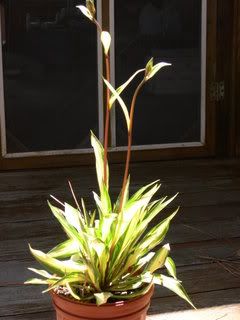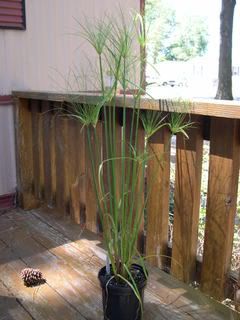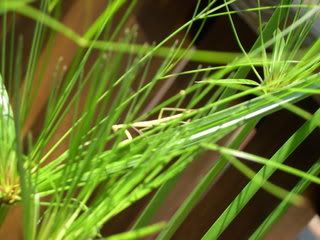Papyrus and the Cherry Berry Hosta
As promises, today I'm blogging about the new plants I got on vacation. In Delaware, where my family vacations, THE place to go for plants is off the beaten path just outside Millsboro. East Coast Perennials (sorry, I couldn't find a web address, but you can Google it for directions) has it all. From shrubbery to tropicals if you can't find it there, they'll be happy to order it for you.
So no vacation, for me, is complete without at least one stop there to see what's new. About mid-way thru last week, on a cloudy day, we decided to take a short trip to East Coast Perennials, not with any intention to buy, mind you, just looking.
Well, you know how that goes ... it wasn't long before I found a new type of Hosta that I hadn't seen before. Sheltered under a scrim in the "shade plants" area was the Cherry Berry Hosta.

Hosta Cherry Berry immediately caught my eye because it has red stems (for purple blooms) and bright red seed pods. It is also one of the smaller hostas. It has untraditionally long and thin leaves, yellow trimmed with green. I'm told the yellow will later turn to white in the fall. And unlike other shade-loving hostas, I was told by the helpful staff that Cherry Berry grows best when it is planted in an area that receives some direct sunlight.
I'm still trying to choose the right spot.
The other plant I had to have was a Papyrus for the pond. I had a dwarf papyrus when I first started ponding, with my smaller pond. It is only an annual in our zone (6), so it doesn't survive the winter. Lately around here, I haven't been able to find a nice papyrus for under$16, but they were on sale at East Coast Perennials for the bargain price of $4.50!! And that was for the giant size!

The Papyrus is described as a bog plant (which means it likes mostly still water), so I'll be putting it in a corner of the pond that doesn't get a lot of water flow. An interesting aspect of this plant is that if the top of a stalk falls in the water, a new plant will grow. It is almost as if the roots of these plants are on the top. It's spindly spikes will add a nice contrast to the broad leaves of my Black Taro and Cannas. It's height will add architectural interest to any landscape.

After getting these plants back to our vacation place, I put them on the deck and made sure to keep them well watered. It wasn't until the next morning that I noticed a special little visitor on one of the papyrus' leaves. If you look very closely here, you should be able to see a tiny little lime green praying mantis. I tried many times to get a better shot, but because it's so small and thin, the camera couldn't figure out what I wanted it to focus on ... by the afternoon the praying mantis was gone. Or at least we thought ... when I went to load the plants for the trip home, something caught the corner of my eye. It was the tiny mantis jumping onto the backseat, thoroughly confused by all the commotion.
Not wanting to confuse it anymore by taking it 150 miles away from its home, I ushered it out of the car and into our flowerbed. See you next trip little guy!!
Coming up ... Tropical Island Delights, balloon flowers and the lacecap hydrangea.

So no vacation, for me, is complete without at least one stop there to see what's new. About mid-way thru last week, on a cloudy day, we decided to take a short trip to East Coast Perennials, not with any intention to buy, mind you, just looking.
Well, you know how that goes ... it wasn't long before I found a new type of Hosta that I hadn't seen before. Sheltered under a scrim in the "shade plants" area was the Cherry Berry Hosta.

Hosta Cherry Berry immediately caught my eye because it has red stems (for purple blooms) and bright red seed pods. It is also one of the smaller hostas. It has untraditionally long and thin leaves, yellow trimmed with green. I'm told the yellow will later turn to white in the fall. And unlike other shade-loving hostas, I was told by the helpful staff that Cherry Berry grows best when it is planted in an area that receives some direct sunlight.
I'm still trying to choose the right spot.
The other plant I had to have was a Papyrus for the pond. I had a dwarf papyrus when I first started ponding, with my smaller pond. It is only an annual in our zone (6), so it doesn't survive the winter. Lately around here, I haven't been able to find a nice papyrus for under$16, but they were on sale at East Coast Perennials for the bargain price of $4.50!! And that was for the giant size!

The Papyrus is described as a bog plant (which means it likes mostly still water), so I'll be putting it in a corner of the pond that doesn't get a lot of water flow. An interesting aspect of this plant is that if the top of a stalk falls in the water, a new plant will grow. It is almost as if the roots of these plants are on the top. It's spindly spikes will add a nice contrast to the broad leaves of my Black Taro and Cannas. It's height will add architectural interest to any landscape.

After getting these plants back to our vacation place, I put them on the deck and made sure to keep them well watered. It wasn't until the next morning that I noticed a special little visitor on one of the papyrus' leaves. If you look very closely here, you should be able to see a tiny little lime green praying mantis. I tried many times to get a better shot, but because it's so small and thin, the camera couldn't figure out what I wanted it to focus on ... by the afternoon the praying mantis was gone. Or at least we thought ... when I went to load the plants for the trip home, something caught the corner of my eye. It was the tiny mantis jumping onto the backseat, thoroughly confused by all the commotion.
Not wanting to confuse it anymore by taking it 150 miles away from its home, I ushered it out of the car and into our flowerbed. See you next trip little guy!!
Coming up ... Tropical Island Delights, balloon flowers and the lacecap hydrangea.

Labels: cherry berry hostas, delaware, east coast perennials, millsboro, papryus, pond plants, praying mantis
 RSS
RSS


